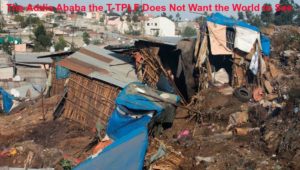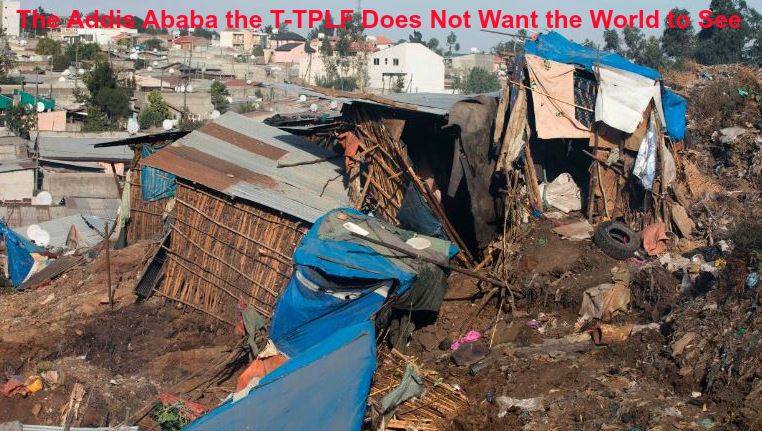Trashin’ Addis Ababa (New Flower)
Author’s Note: The purported prime minster of Ethiopia, Hailemariam Desalegn, is a sanitary engineer with a master’s degree from Tampere University of Technology (TUT) in Finland. The sanitary engineering profession is concerned with the removal and disposal of human waste and finding ways of supplying safe potable water.
Last week, under Desalegn’s personal watch nearly 200 people were buried when a “mountain of garbage” at a landfill commonly known as “Qoshe”, some 13 miles southwest of the capital, collapsed on an adjacent neighborhood.

In May 2017, Desalegn is slated to receive an honorary doctoral degree from TUT. An honorary degree (honoris causa) is given to an individual for outstanding contributions to a specific field of human endeavor or for exceptional contributions to a particular society or the world community.
It is mind boggling for me to consider how a renowned university such as TUT could even consider presenting an honorary doctoral degree to a sanitation engineer who sat at the pinnacle of power and watched in depraved indifference for years and did nothing to prevent the needless deaths of some 200 persons from a collapsing mountain of garbage.
For what accomplishments TUT is awarding Hailemariam an honorary degree?
What has Hailemariam done to improve sanitation in Addis Ababa? What has he done with the education, training and expertise he acquired in sanitary engineering from TUT to improve the sanitation system in Addis Ababa or anywhere else?
Hailemariam casually brushes it all off. He says he knew nothing about the Qoshe dumpsite issue despite the fact that the dumpsite had collapsed on a number of previous occasions with significant injuries and property damage.
Hailemariam specializes in denying responsibility. He said he did not know when his troops massacred over 500 people during the Irreecha Massacres in October 2016.
TUT is now honoring a man who has presided over, if not authorized, at least two documented killing fields.
Shame on TUT, its president and the TUT Foundation Board!!!
I shall promptly serve, and make public, a strongly-worded note of academic protest on behalf of the Qoshe victims and their families on TUT’s president Mika Hanula, Ph.D., and TUT’s Foundation Board Chairman Tero Ojanperä, Ph.D., for their University’s complicity in honoring a man singularly responsible for failing to prevent a great tragedy and for the deaths of 200 poor Ethiopians at their official street and box office address: Korkeakoulunkatu 10, FI-33720 Tampere, FINLAND; PO Box 527, FI-33101 Tampere, FINLAND. I urge all Ethiopians throughout the world, and particularly Ethiopians and their friends in Finland, Norway and Sweden, to protest the award of the honorary degree to Desalegn.
Addis Ababa, the Potemkin Village
 A Potemkin village is a metaphor for “something that appears elaborate and impressive but in actual fact lacks substance.” It is a village of smoke and mirrors. It is like the back lot sets at the movie studios with an attractive exterior façade and nothing in the interior. A Potemkin village is a game of deception complete with illusions, make-believe props and sleights of hand. It is a dog and pony show which is staged to impress, to thrill, to overawe and to grandstand.
A Potemkin village is a metaphor for “something that appears elaborate and impressive but in actual fact lacks substance.” It is a village of smoke and mirrors. It is like the back lot sets at the movie studios with an attractive exterior façade and nothing in the interior. A Potemkin village is a game of deception complete with illusions, make-believe props and sleights of hand. It is a dog and pony show which is staged to impress, to thrill, to overawe and to grandstand.
In a Potemkin village, everything is masked to divert attention from the truth and distort the hard realities and ultimately deflect responsibility. In a Potemkin village, the aim is to manipulate public opinion and when that fails disorient, confuse and frustrate the public.
The ruling Thugtatorship of the Tigrean People’s Liberation Front (T-TPLF) has created a Potemkin village in Ethiopia, and particularly in Addis Ababa.
The T-TPLF has done everything it can to 1) conceal the true picture of the dire and miserable socio-political and economic situation in the country, 2) create an imaginary and deceptive narrative of Ethiopia as the rising “developmental state” modeled after Singapore, South Korea and Malaysia and 3) paint a picture of Ethiopia as the shining “middle income country” to become by 2025.
The late T-TPLF thugmaster Meles Zenawi proclaimed a public relations campaign called “Ethiopian Renaissance” to cleverly discredit the great Ethiopian Emperor (Emye) Menelik II and project himself as the “father of modern Ethiopia”.
The T-TPLF has created the Potemkin village of Ethiopia to distract prying and probing eyes from the truth. The T-TPLF has done it with a media campaign of lies, damned lies and statislies. They have done it by spreading junk data like horse manure. They have used garbage in, garbage out data to prove double-digit growth. They have done it with trash talk about democracy and winning 100 percent of the seats in parliament. Suffice it to say that I have proved beyond a shadow of doubt that the claims of double-digit growth is a doggone lie fabricated in the T-TPLF’s statistics factory.
In creating the Ethiopian Potemkin village of double-digit growth, the T-TPLF has colluded with the brown-nosing expert international poverty pimps who ingurgitate the aid and loans given to the Ethiopian people like blood-sucking ticks on farm animals and the mindless and lazy foreign media who would rather propagate official lies than challenge the bold-faced liars who use them like five-dollar tricks.
What is the truth from which the T-TPLF is running away?
Under the T-TPLF, Ethiopia has become the second poorest country in the world and the beggar nation of Africa panhandling for handouts year after year after year.
The T-TPLF wants to hide the fact that it has drained the lifeblood of Ethiopians over the past 25 years. In 2011, Global Financial Integrity (GFI) reported,
The people of Ethiopia are being bled dry. No matter how hard they try to fight their way out of absolute destitution and poverty, they will be swimming upstream against the current of illicit capital leakage.”
The GFI report further documented that “Ethiopia, which has a per-capita GDP of just US$365, lost US$11.7 billion to illicit financial outflows between 2000 and 2009.”
Under the T-TPLF, Ethiopia has become bankrupt and a deadbeat nation mooching off international donors.
The African Development Bank in its “Country Strategy Paper for 2016-2020” says Ethiopia is drowning in debt. “Ethiopia’s external debt stock has soared fivefold, from USD 2.8 billion in 2008/09 to USD 19 billion in 2014/15, up from 12.1% of GDP in 2009/10 to 26.2% in 2014/15. Yet, the T-TPLF crew sucks the financial lifeblood of Ethiopia.
As part of its public relations efforts, the T-TPLF has installed a barely functional light rail system in the Potemkin village of Addis Ababa. It has also launched a long haul railway system; but both rail systems today teeter on the verge of bankruptcy.
The T-TPLF has embarked on various public relations white elephant projects including a dam on the Blue Nile River and another dam which has destroyed the lives of hundreds of thousands of indigenous people in the Omo River Basin in Southwestern Ethiopia. Constant power outages in the capital are a daily fact of life in Addis Ababa and elsewhere.
The T-TPLF has built shiny glass buildings and rudimentary infrastructure in the capital, which according to various engineering reports are described “low quality” and constructed with “insufficient attention being paid to issues of environmental performance and life-cycle analysis” and in the “absence of any consideration for pedestrians in urban design and construction management.”
Nowhere is the T-TPLF Potemkin village in Ethiopia more glaringly visible than in the urban infrastructure housing and sanitation sector.
A 2011 U.N. Human Settlements Programme report stated Addis Ababa needed 300,000 new homes with only 30% of existing properties in “fair condition”.
A 2015 U.N.-HABITAT report described “70 percent” Addis Ababa’s housing stock as “informal”. As rural migration in to the capital increases by nearly 4 percent annually and the T-TPLF uses eminent domain to take property from the poor to hand it over to its cronies, supporters and others who are prepared to “grease its palms”, housing shortages have increased sharply and the masses of the urban poor are forced to construct informal housing in backyards of existing housing stock, while others are forced to relocate to the periphery of the capital. To add insult to injury, the T-TPLF calls the urban poor it has displaced “squatters” and “illegal settlers” , when in fact it is the T-TPLF that is creating illegal settlements by its criminal use of the powers of eminent domain to give its rich supporters the land that once belonged to the poor.
The Qoshe “garbage mountain” disaster
On March 9, 2017, under Hailemariam’s watch, dozens of people died when, as the Washington Post described it, an “artificial mountain of garbage, where people scrap out a living combing through the refuse” collapsed. According to a Reuters report, 115 persons were exhumed from the “mountain of garbage” at the Qoshe landfill and emergency workers “expect to pull more bodies” in the coming days. Residents reported “at least 80 people remained unaccounted for.”
The Qoshe landfill is over one-half century old and occupies some 37 hectares. It is the site for the disposal of millions of tons of waste every year from the capital city. Surrounding the landfill are makeshift shelters constructed from mud and wood and plastic sheeting. The residents include not only the urban homeless poor scavenging for food and recyclable items but also the working poor whose properties have been demolished by the T-TPLF, paid pennies in compensation and their land handed over to T-TPLF crony land developers.
What caused the March 9 garbage collapse disaster?
There appear to be at least two persuasive and compelling explanations.
One survivor of the Qoshe disaster gave the following shocking account to the Voice of America- Amharic program:
This situation could have been changed from the very beginning. This is not the first time this thing [collapse] has occurred . It is not the second time. It is not the third time. In six years, it is a disaster that has occurred repeatedly for the fourth and fifth time. The accumulated trash had collapsed even before six years ago. We have spent our money and pooled our labor to try and fix the problem. We planted trees and other defenses to prevent the trash from collapsing but the government demanded that we turn over the land for development and so we did. As a result, there was nothing to defend against soil erosion which triggered the collapse of the trash and as a result caused a disaster in the neighborhood. The trash did not collapse because too many people live close to the trash site or because of excess of trash accumulation. From the beginning when they [government] began digging to build a road, residents of the area expressed concerns about the situation but the [government] ignored warnings that the road construction [on side of the accumulated trash] could loosen the ground creating a collapse. The plea of residents in the area that beginning construction on the side of the trash heap without removing the trash could result in a disaster was ignored.
In an “in-depth analysis of the Qoshe garbage dump collapse”, Addis Standard in its March 17, 2017 report provided a number of clues to the mixture or corruption, fraud, abuse and waste in the management of solid waste in Addis Ababa and the deadly interplay of T-TPLF’s urban renewal (confiscation) policy and poor people’s removal consequences from the highly lucrative urban areas:
The massive scale of decades-old evictions of the poor from the center of the city is by all measures, a corruption-infested practice by city administration officials.
Qoshe as the only open dumpsite in the city had outlived its original purpose and had no facilities such as fences, drainage systems, odor control, or recycling methods.
A decade-old commission established to manage the dump site had failed to manage it properly.
The city government of Addis Ababa was fully aware of the gravity of the Qoshe situation after a major disaster in 2009.
Instead of mitigating the Environmental and human impact of the Qoshe dumpsite, the “authorities” (that is the T-TPLF) began selecting alternative sites and closure and conversion of Qoshe into a public park.
In 2012, T-TPLF officials went on their usual panhandling spree to beg money for the construction of a state-of –the-art solid waste management operation. They visited various European and other capitals and engaged in “shrouded backdoor negotiations”.
As a result of the negotiations, several donors, including the US, responded positively and provided large amounts of grants to the city administration to improve solid waste disposal. With a US$337 million grant secured from the French government and the work given to VINCI Grands Projets, a French construction company, the T-TPLF launched work on the Sendafa Sanitary Landfill.
VINCI Grands Projets was paid may be half of the initial amount it won the contract for and even that, it was done in bits and pieces with several delays.
The Sendafa Sanitary Landfill opened in February 2016 giving respite to Qoshe in 53 years, but six months into its service, Sendafa Sanitary Landfill imploded, leaving Addis Abeba to explode with its waste.
The Sendafa Sanitary Landfill was not only incomplete when it started receiving the city’s solid waste, but also none of the four waste transfer stations incorporated in the plan were built.
The T-TPLF made another USD$158 million with U.K.-based Cambridge Industries to turn deal Qoshe into a 50mw waste-to-energy plant.
and a project office assigned to do the job – Addis Abeba Waste Recycling & Disposal Project Office –f VINCI Grands Projets, a French construction company (
Simultaneously, city administration officials have assigned a US$158 million for a project to turn Qoshe into a 50mw waste-to-energy plant and have awarded the contract to the UK-based Cambridge Industries; Sendafa Sanitary Landfill experienced, the Qoshe waste-to-energy project has already missed its opening deadline several times.
In October 2016, the Addis Ababa city government spent close to US$5 million to purchase 25 compactors and ten road sweepers. This was the city government second time the agency made such huge investment to buy compactors. Already in 2012, it bought 19 compactors at a cost of US$3.9 million; almost all of them were sitting idle by the time Sendafa Sanitary Landfill was opened.
The evidence in the Qoshe disater and solid waste management in Addis Ababa clearly points to corruption, waste, fraud and abuse and depraved indifference and bureaucratic incompetence of T-TPLF officials in the prevention of the Qoshe disaster on March 9, 2017.
There is no question that T-TPLF officials were factually aware of the high likelihood of a recurrence of collapse that Qoshe dumpsite as they had established a special committee to deal with it in 2009.
Why did the T-TPLF regime allow settlements around the Qoshe landfill?
The Qoshe dumpsite emits methane gas from decomposing trash. There are even smoldering fires with visible smoke. The putrid smell emanating from the landfill is intolerable. Yet, for years the T-TPLF turned a blind eye as thousands of citizens rummaged through the trash and built make-shift shelters.
Hailemariam Desalegn knew of the Qoshe dumpsite both as a sanitary engineer and as the putative prime minister.
Neither Hailemariam nor his T-TPLF bosses have an explanation for their failure to take preventive or protective action to safeguard public health and safety in the hazardous operation of the Qoshe dumpsite.
But the chief researcher for Amnesty International in Ethiopia, Fisseha Tekle, has a clear explanation:
The government claims it has been developing for the last decade but was not able to take residents out of this deplorable situation. And those people are living in the middle of that [Koshe landfill] location. It’s not a landfill anymore, it’s like a mountain. Whatever kind of country you are, you cannot let people live in this situation. The government is fully responsible for the people living on this site and for their condition of those people who died, and for their lack of safety.”
In a formal statement, Amnesty International declared:
The Ethiopian government is fully responsible for this totally preventable disaster. It was aware that the landfill was full to capacity but continued to use it regardless. It also let hundreds of people continue to live in close proximity to it. These people, including many women and children, had no option but to live and work in such a hazardous environment because of the government’s failure to protect their right to adequate housing, and decent work.
Qoshe garbage mountain collapse is only the tip of the iceberg of Ethiopia’s environmental collapse
In his 2005 book, “Collapse”, Prof. Jared Diamond identifies five factors that contribute to societal collapse: climate change, hostile neighbors, collapse of essential trading partners, environmental problems, and failure to adapt to environmental issues. (For those not interested in reading the book, I recommend Diamond’s Ted Talks presentation HERE.)
The T-TPLF’s final solution to the Ethiopian problem is to “Collapse” it through massive scale environmental degradation, uncontrolled high population growth, massive population displacements and land grabs, construction of unsafe, poorly designed and low quality dams, provoke water wars with neighbors, turn a blind eye to environmental pollution and accelerate deforestation all in the name of economic development.The “Ethiopian Agricultural Research Institute” says Ethiopia loses up to 200,000 hectares of forest every year. Between 1990 and 2005, Ethiopia lost 14.0% of its forest cover (2,114,000 hectares) and 3.6% of its forest and woodland habitat. If the trend continues, what could happen in 2025 or 2050?
I have always been more deeply concerned about environmental collapse in Ethiopia more than political collapse. Governments and regimes come and go, but damage to the environment impacts generations to come.
I first wrote about the T-TPLF’s crimes against nature in March 2009. In that commentary, I discussed the enormous human toll resulting from the toxic waters of Lake Koka, once a pristine lake located some 50 miles south of Addis Ababa. A health worker at the time explained that the people in Ammudde [Lake Koka area] “are more sick than the other people who are not using that water. It will be about two-thirds more… Most of them have stomach disease and diarrhea is common. They are drinking the water that is contaminated from the [leather] factory, so they get sick from that chemical.” Those people today are still dying.
In 2012, I joined the efforts of international conservationists to protect the indigenous people of the Omo Basin in Southwestern Ethiopia from the serious hydrological risks posed by the construction of the so-called Gibe III dam.
In 2011, I sounded the alarm on population growth in my commentary, “Ethiopia: Apocalypse Now or in 40 Years?”. I tried to call attention to the July 2011 U.S. Census Bureau’s frightening population forecast: By 2050, Ethiopia’s current 90 million population will more than triple to 278 million, placing that country in the top 10 most populous countries in the world.
Ethiopia did not produce enough food to feed 25 million people in 1974; or 40 million in 1984; or 55 million in 1994; or 74 million in 2004 and 100 million people in 2017.
Will it be Apocalypse in Ethiopia in 2025? 2050? That should be food for thought for all of those who are today fighting to get into or cling to political power.
Hear! Hear! You will all be fighting to rule over a nation of corpses!!!
The right to a safe environment
Article 92(1) of the “Ethiopian constitution” written by the T-TPLF provides, “Government shall endeavor to ensure that all Ethiopians live in a clean and healthy environment.” Like every single one of the 106 “articles”, the T-TPLF ignores the commandment of Art. 92 with depraved indifference.
The T-TPLF’s Proclamation No. 513/2007 aims to regulate “solid waste management” in urban areas. Like everything else, the T-TPLF leaders think that writing words in the constitution or a proclamation will make it happen magically. Of course, neither of these legal authorities have any meaningful application under T-TPLF rule. Indeed, I will bet my bottom dollar that none of the top T-TPLF leadership have ever read their own constitution or the proclamations they crank out like cheap hamburgers.
The T-TPLF’s Perverted Logic
For the T-TPLF, large trash production is a sign of economic development because it shows high consumption .
One rather dubious 2015 study which appears to support of the T-TPLF’s “developmental state” approach argues that Ethiopia “like any agriculturalist economy at the early stage economic growth inevitably contribute for environmental degradation. Later on environmental degradation starts to decrease with increasing economic growth.”
In other words, the study, stripped off its intellectual pretensions, the study effectively argues that environmental degradation is a necessary precondition of development in Ethiopia. Reading George Ayittey’s piece in this regard may prove to be enlightening.
Land grabs, mass displacements and sanitation in Ethiopia
The T-TPLF would do anything to conceal the data presented below, but the facts are just the facts, bogus claims of double-digit economic growth and all of the other fairy tales to the contrary.
The data on sanitation in Ethiopia and the capital city are simply appalling. A 2015 study based on a “nationwide inventory” revealed:
more than half of the Ethiopian population (52.1%) still used unimproved sanitation facilities in 2014. The majority (35.6%) practiced open defecation, implying that the country is far from the MDG target for access to improved sanitation (56%). Most people in urban slums (88.6%) used unimproved sanitation facilities, indicating that the urban poor did not receive adequate sanitation services. Trend analysis shows that access to ISC has increased, but Central Statistical Authority (CSA) data reveal a decline. This discrepancy is due to differences in data collection methods and tools. Dry pit latrines are the most widely used toilet facilities in Ethiopia, accounting for about 97.5% of the ISC.
The sanitation data on Addis Ababa, the hub of the African Union and other international organizations, shows:
Open defecation is practiced by 8.2%, 5.8%, and 8.0% of slum residents in Addis Ababa, the total Addis Ababa population, and all urban areas of the country, respectively. The majority of Addis Ababa’s slum dwellers (88.6%) and 73% of its total population use unimproved sanitation facilities, showing that the urban poor are the population segment with the poorest access to sanitation services. In conclusion, urban sanitation coverage is far from the MDG target and the majority of urban residents live with high health and environmental risks.
A 2015 USAID study of 30 cities/towns of Ethiopia showed:
Open-field urination and defecation were highly practiced among the urban community. Organizational setups for proper urban municipal sanitation and waste management were not fully functional because of low salary, placement, and motivation.
The management of liquid waste at household level was very poor. About half of the households handle grey water (household liquid waste) by openly discharging into any accessible public properties, such as streets, and nearby open space. The overall USWM (urban sanitation waste management) situation was grossly poor, characterized by poor linkage between policies/strategies and operational practices.
Another 2015 study of “trends of access to sanitation in Ethiopia” showed the majority of urban slums (88.6%) used unimproved sanitation facilities including open field defecation. The “Ethiopian-Central Statistics Agency”s” 2014 survey estimated 82.5% of urban and 95.5% of national population have no access to improved sanitation. According to the study, “safe and resource recovery oriented FSM (fecal sludge management) system is totally absent in Addis Ababa.” These problems have persisted for and documented over a very long time.
In 2008, the World Health Organization estimated that 64% of people in Ethiopia defecate in the open, although that was down from 91% in 1990. That report indicated that the lack of toilet facilities and general poor sanitation in the city are some of the leading causes of disease and death in the country.
In 2005, according to the World Health Organization, only 22 per cent of Ethiopia’s 81 million people had access to safe water and only 13 percent of the population had access to sanitation . USAID recommended the “next step in Ethiopia’s WSS (water supply and sanitation) sector development must be focused on local WSS service provider capacity building so that national policies and strategies are effectively implemented and sustainable service expands to semi-urban and rural populations.”
At the time, even USAID expressed considerable doubts on the T-TPLF’s ability to properly use the money to improve sanitation. “It is not known whether Ethiopia has the capacity to effectively and efficiently utilize even the current available amounts, much less any additional allocations, although additional capacity to absorb new funding is being scaled up through donor coordination.” Aha! There was a time when USAID was able to call a spade a spade and tell the truth. Peter Ustinov, the eminent English dramatist, intellectual and diplomat once observed, “Corruption is nature’s way of restoring our faith in democracy.” Is that what Trump means when he says, “Drain the swamp”?
The T-TPLF’s “National Hygiene and Sanitation Strategy”, published in December 2005, claims “To Enable 100% Adoption of Improved Hygiene and Sanitation” based on “three pillars” (pp. 34-37): 1) creating a framework to develop policy consensus, legislation, political commitment, intersectoral co-operation, partnership and capacity building; 2) promote sanitation and hygiene through participatory learning, advocacy, communication, social marketing, incentives or sanctions, and 3) improved access to strengthen the supply of sanitation through appropriate technology solutions, product and project development, and support to local producers and artisans.
Over a decade, later there is little evidence that the T-TPLF has even attempted to implement the strategies let alone implement them effectively.
According to a 2007 UNICEF report, “Water-borne diarrhoea results in over 500,000 child deaths each year, and 60 to 80 per cent of all diseases in Ethiopia are water and sanitation-related. It is hoped that the rapid construction of latrines in this region will curb deaths and create a healthier environment for women and children.” Today millions of Ethiopian children and adults die or are severely disabled from sanitation and hygiene-related diseases.
A 2014 assessment of environmental awareness education on solid waste management in one particular district of Addis Ababa showed, “The practices and implementation appear at low level. Some of the factors that hindered the proper practices of solid waste management [include] lack of waste management facilities in the locality, lack of stake holders participation and commitment, and lack of adequate community participation.” So much for the “National Hygiene and Sanitation Strategy”.
A 2014 report in the Guardian made the stunning revelation that “Addis Ababa has more than 3 million people, but there are just 63 public toilets.”
That means there are 63 certified locations for the breeding and propagation of untold types of infectious diseases.
As far as I am concerned, there is no better statistic that is more telling about T-TPLF’s Potemkin village of Addis Ababa.
The T-TPLF boasts of 10-12 percent annual growth in Ethiopia over the past decade. Yet it has only 63 public toilets for 3 million people, that is 1 toilet for every 47, 620 persons.
What more can I say!!!!!!
Ethiopians are dying by the tens of thousands every day under the T-TPLF mountain
To me, the Qoshe mountain of garbage collapse is merely a metaphor for what is happening in Ethiopia under the putrid T-TPLF mountain.
The T-TPLF mountain is collapsing on Ethiopians every day and killing and maiming thousands.
There is no question the 50 plus year-old mountain of trash at Qoshe needs immediate disposal.
So does the 25 year-old political trash!
I wonder if TUT is honoring Hailemariam for making Ethiopia one large Qoshe!





